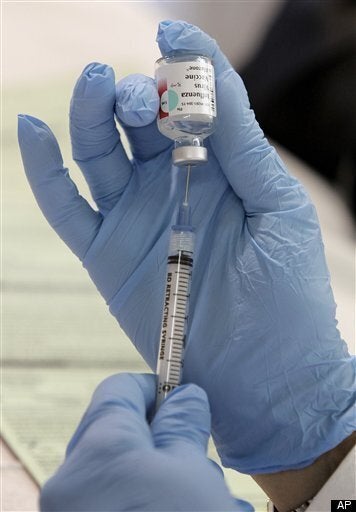
Though in some cases I am pro-vaccine, I am not pro-flu vaccine, because its effectiveness remains unproven and its safety in question.
The importance of vaccines in advancing public health cannot be overstated. Last year, after the earthquake in Haiti, I cared for a man dying of tetanus. There is no excuse for his death. Today, even in the remotest villages on the planet, villages without television and cell service people can quench their thirst with a bottle of Coca-Cola. We should have been able provide a vaccine for tetanus. Sanitation, clean water and other social and structural changes in society led to the reduction of deaths from infectious disease. Smallpox has been eradicated through a global vaccination policy. Whopping cough, polio and other childhood diseases have been reduced through successful vaccination programs. Vaccinations are one of the greatest advances in medicine in the 20th century.
But just because vaccinations have worked so well for prevention of some diseases, does not mean that all vaccines are effective or safe. Vaccinations are a medical procedure and should be subject to the same standard of evidence and rigorous scientific inquiry before strong recommendations are made for their global application by government institutions.
Should Our Government Strongly Recommend the Flu Vaccine?
The wholesale acceptance and promotion of the flu vaccine by government agencies, heath care institutions, pharmacies and physicians is at best based on flimsy, flawed or inadequate evidence. And at worst, it pushes a potentially harmful medical procedure on a poorly informed public.
Consider this. What consumer product creates billions in profits for it manufacturer every year and is recommended and almost mandated by our government to be used by all Americans over six months old? The flu vaccine.
Not only does our government's public health marketing campaigns generate billions in profits for vaccine manufacturers, but those companies are protected from legal liability by the U.S. government. Yes, that's right. If a vaccine harms or kills an American citizen, the government will pick up the legal bill and the settlement for damages. This would be an acceptable risk if flu vaccines were proven to be effective and were free of side-effects such as the life threatening paralysis called Guillain-Barre Syndrome that affects one in a million flu vaccine recipients. If all "eligible" Americans were vaccinated there were be 300 lives adversely affected. But unfortunately unlike many other vaccines, medications and medical procedures in use today, the flu vaccine has not passed the scientific litmus test.
What the Science Says About the Flu Vaccine
Let's briefly review the evidence for and against the flu vaccine based on an independent objective scientific, comprehensive review of ALL the evidence. And let's look at a few logical holes in our current thinking and public policy about vaccines.
Top line, here are the conclusions. For those who want to dig deep and decide for themselves I encourage you to read the recent review paper by the international, independent, non-profit Cochrane Collaboration group published in July of 2010.
1.A comprehensive of the flu research in healthy adults aged 18-65 from 1960 to the present including over 40 clinical trials with over 70,000 people found no evidence of benefit for the flu vaccine. Most trials were poorly done, or inadequate to reach clear conclusions. Only the best 50 studies were included in the final analysis.
2.The only studies that showed benefit were industry funded. Despite this bias they tended to be published in the most prestigious journals and were the ones most widely quoted, while the publicly funded studies were less likely to show favorable conclusions.
3.They found cases of severe harm and inadequate reporting of adverse effects of the flu vaccine.
4.There are different 200+ strains of flu and viruses that infect people every year. The vaccine covers only about 10 percent of the virus strains that make people sick.
5.If the vaccine strain given in a particular vaccination happened to match the virus caught by the vaccinated person, the likelihood of getting sick from the flu was only reduced from 4 percent to 1 percent.
6.There was NO evidence that the vaccine reduced transmission of the flu (a major rationale for mass vaccination) or complications such as pneumonia (another major justification).
7.These conclusions included the data from biased industry studies yet still found no benefit except small reductions in flu symptoms in some industry studies.
8.They warned that their already negative conclusions may be UNDERSTATED because of the inclusion of industry funded studies in their review.
Authors of scientific papers tend to understate their conclusions. They report findings in neutral language and let that data speak for itself. However, these independent researchers concluded this review with the following statement about the flu vaccine.
The review showed that reliable evidence on influenza vaccines is thin but there is evidence of widespread manipulation of conclusions and spurious notoriety of the studies. The content and conclusions of this review should be interpreted in light of this finding.
...The results of this review seem to discourage the utilization of vaccination against influenza in healthy adults as a routine public health measure. As healthy adults have a low risk of complications due to respiratory disease, the use of the vaccine may be only advised as an individual protection measure against symptoms in specific cases.
That is why it is perplexing to me that our Centers for Disease Control recently changed its policy advising vaccination only for sick or at risk populations to ALL Americans over six months of age.
If the science doesn't support use in healthy adults from 18 to 65, then what about other at risk populations? Unfortunately the story is not much better there.
Why We Should Think Twice About Getting the Flu Vaccine
Industry studies typically claim that the vaccine will reduce the winter death rate by half in vaccinated individuals. Sounds great, but researchers from the National Institute of Allergy and Infectious Diseases found that deaths from illnesses that the flu aggravates like heart failure or lung disease, account for only 10 percent of winter deaths in the elderly. Dr. Jefferson from the Cochrane Collaborative said that industry claims of a 50 percent to 90 percent reduction in ALL deaths in the winter would have to include reduction of deaths from falls, fires, heart disease, stroke and car accidents. "That's not a vaccine, that's a miracle," he said.
Other bits of data also call into question the effectiveness and usefulness of vaccines. In 2004, vaccine production dropped leading to a 40 percent reduction in vaccination rates. But death rates that flu season did not increase. In other years, 1968 and 1997, the strain of vaccines produced didn't match the circulating viruses that season, which meant that, in effect, nobody was vaccinated those years. And yet death rates from all diseases including flu related illness did not change at all.
Also reductions in sickness and death rates in vaccinated individuals may be due to the health user effect. People who are motivated to take care of themselves -- eat better, exercise, get enough sleep, take vitamins -- are also the ones most likely to take advantage of vaccines and preventive medicine. Avoiding the flu for them might have nothing to do with actually getting the vaccine. These types of studies are "cohort" studies -- observing populations over time. They are not intervention studies, which control for confounding factors like the healthy user effect.
Dr. Lisa Jackson tested this hypothesis in over 72,000 people 65 and older and found that those who did NOT get the flu shot were 60 percent more likely to die OUTSIDE of flu season. They died because they were sicker to start with. And the vaccine recipients didn't die at the same rate because they were healthy! Also the ability of the vaccination in the elderly to create an immune response and bolster immunity against the flu is impaired. Young adults have a better immune response, but as we have seen, they don't benefit from the vaccine in terms of reductions in transmission, hospitalization or severe illness. So the ones who may benefit, the elderly, the vaccine doesn't take.
This same blunder based on the "healthy user effect" occurred with Premarin. During the height of the hormone craze after the "cohort" Nurses Health Study showed that the hormone users were 50 percent less likely to have heart attacks, over 50 million women took Premarin. One of my patients said her gynecologist told her it was malpractice NOT to prescribe estrogen. It was unethical not to prescribe estrogen to all menopausal women we were told. But only until the National Institute of Health's randomized controlled study known as the Women's health initiative, found that in fact Premarin cause 50 percent more heart attacks, strokes and breast cancer. Then, overnight, our recommendations changed.
Many vaccine advocates suggest that it is unethical to withhold vaccinations from the population because of the evidence (however weak we now know) of benefit. Giving some vaccines and other sham vaccines to study effectiveness and safety is not unethical. It is called science, and until we have clear evidence of benefit from randomized controlled trials we should not have government policy advocating mass vaccination while protecting vaccine manufacturers lawsuits due to any harm.
Individuals self-selecting to get a vaccine while understanding the risks and potential benefits (or lack thereof) are one thing. But government policies, advocacy and marketing of unproven vaccines that generates billions in profits for industry while absolving them manufacturers of proving effectiveness and protecting them from any liability must be changed to match the objective evidence. Shouldn't the government be in the business of protecting citizens and not corporations.
The false sense of safety from vaccination often prevents people from doing the very things we know work to prevent viral illness including washing our hands, staying home when sick, getting more sleep, eating a healthy diet, getting moderate exercise and taking some basic nutritional supplementation. A randomized trial of 1200 U of vitamin D a day reduced the risk of getting the seasonal flu by 42 percent. Now that's an easier pill to swallow.
Mark Hyman, M.D. is a practicing physician, founder of The UltraWellness Center, a four-time New York Times bestselling author, and an international leader in the field of Functional Medicine. You can follow him on Twitter, connect with him on LinkedIn, watch his videos on YouTube, become a fan on Facebook, and subscribe to his newsletter.
